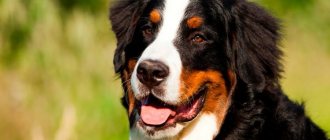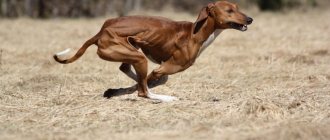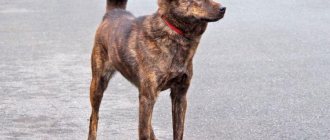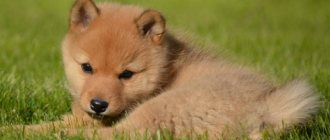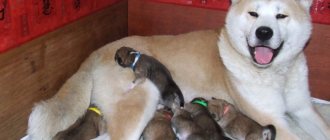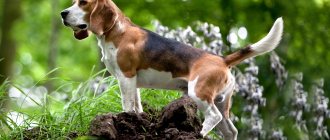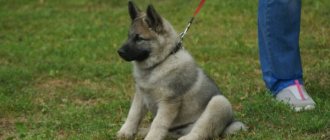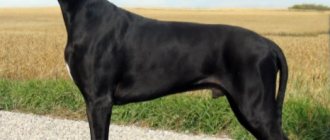The Beagle is a hunting dog that originated in Great Britain.
It is distinguished by long floppy ears and a muscular body.
As befits hunting breeds, they have a very good sense of smell. These dogs are kind, smart and loyal. The advantages of this breed are also endurance and unpretentiousness.
Previously, in medieval England, beagles were used to track down deer and roe deer. They were also excellent at hunting hares.
Nowadays, few people use beagles for such purposes, but they become excellent friends and lovely pets for their owners.
History of the breed
Officially, this dog breed dates back to the 14th century in Great Britain. Externally, Beagles are somewhat similar to the Harrier dog breed, as well as other hound breeds. Beagles were originally bred to be used for hunting hares and tracking deer. Thanks to this, they became faithful assistants to the nobles of Foggy Albion, who cannot imagine their lives without hunting.
Regarding where the word “beagle” itself came from, there are several versions. One of the most popular says that it is taken from the French language and is similar to the word “begueule”, which translates as “open throat”. Allegedly, representatives of the breed received this name due to their unique voice. But, there is another version that says that the Beagle breed got its name from a word from the Gaelic language, which is the dialect of the Scottish Celts.
It is not easy to accurately trace the history of the origin and development of the breed. The reason lies in the fact that until the 19th century practically nothing was known about it. In Greek writings from the fourth century BC. e. There is a mention that the ancient Romans had dogs whose outward description was very similar to beagles.
It is believed that it was the Romans who brought the first ancestors of modern beagles to the territory of modern Great Britain specifically for hunting small rodents, in particular rabbits. And already in England, the long-term development of the breed began by crossing it with other local breeds of hounds. In addition, there is historical evidence that says that the appearance of beagles in Great Britain took place thanks to William the Conqueror. It was he who brought beagles to England from his campaign in Normandy. This was in 1066. It is also believed that these dogs are the ancestors of the Foxhound.
Beagles gained popularity among the local aristocracy during the reigns of Edward II and Henry VII (XIV-XV centuries). Surprisingly, at that time these dogs were so small that they were the size of an ordinary glove. Elizabeth I even had a real pack of “pocket” beagles. We can judge the appearance of dogs of that time thanks to paintings in which artists often depicted beagles - tiny dogs with a sharp muzzle and short legs are surprisingly small.
In the eighteenth century, fox hunting became especially popular. Too small beagles would no longer be able to fight these animals on equal terms. However, thanks to the efforts of farmers in Ireland, England and Wales, the breed did not fall into oblivion as unnecessary and was preserved. They continued to enjoy the advantages of beagles while hunting hares and rabbits. The dogs coped with this task perfectly.
The 19th century was marked by attempts to breed the breed, and this, however, was successful. Thomas Johnson was responsible for the process of breeding hunting dogs. It was during that period that the breed called “beagle” was formed as we know it today.
Beagle breed standard
The first officially accepted breed standard was edited several times. The breed standard that is officially accepted today and used at dog shows by the international federation FCI was finally adopted in 1987.
So, the following external signs are typical for beagles:
Strong, devoid of excessive coarseness physique. The average height of a dog varies from 33cm to 40cm.
The head is slightly elongated, looking powerful, but not rude. There are no folds or wrinkles. The muzzle is blunt, not pointed. The nose is most often black, but in representatives of the light-colored breed (red bicolor), the nose can be a lighter shade.
The skull is dome-shaped with a pronounced occipital protuberance.
The eyes are large, hazel or dark brown. However, they are not convex. It is noted that such eyes make these dogs look good-natured.
The lips are slightly droopy and have a scissor bite.
Ears of medium length. If extended along the entire length of the muzzle, they will reach the tip of the nose. The ears are thin, rounded, low set and hang down.
The neck is strong and long enough, thanks to which the dog easily follows the trail of an animal.
The body is medium-sized, the back is straight. The belly line is tightened, but not particularly so. The lower back is flexible.
The forelimbs are characterized by the absence of narrowing downwards. Pasterns are short.
Beagles have muscular thighs and fairly strong hocks, thanks to which they can rush along the scent for a long time and not lose ground. When the dog moves, its forelimbs are thrown forward, while the hind limbs act as support for the step, the movements are free and even.
The tail is of medium length, does not lie flat on the back, and does not curl into a ring. Directed upward, but usually it is in motion almost all the time.
The coat is thick and short, the same length regardless of the part of the body.
The color of beagles should be discussed separately. A distinctive feature is the tip of the tail - it should always be white. The coat color is usually a combination of the three beagle colors - white, red and black, which can be combined in various ways. The most common color is tricolor (all three of the above colors are represented approximately equally on different parts of the body).
In addition to the tricolor, the following clarification is indicated:
- black – black predominates in the back area;
- shiny – white predominates.
There are also beagles of bicolor color (consists of two colors). This means that white goes with various shades of red. The dog's coat can be red and white, lemon white, etc. Black and white color is also extremely rare. In Britain, bicolor is most valued.
Representatives of the breed that have the other two colors on a white background are also quite rare. In this case, they are called variegated. To clarify the color, they can be called lemon-pied, badger-pied, hare-pied, based on the predominant color.
As you can see, the color of beagles is quite diverse. It is not limited to the familiar tricolor, due to which dogs of this breed often look very different from each other.
Hunting with a beagle
Beagles have well-developed hunting instincts. A keen sense of smell allows you to sense prey at a great distance. The animal is completely immersed in work, without being distracted by extraneous stimuli.
Beagles can hunt a wide variety of game:
- hares;
- ducks;
- wood grouse;
- woodcocks;
- black grouse, etc.
If desired, the pet can be trained to hunt a beaver, roe deer, deer or wild boar. However, the dog may have its own preferences. If she flatly refuses to take a certain game, it is better not to force it, but to find another use for it.
When hunting, the beagle is very persistent - he pursues the victim to the bitter end, until the hunter kills it. Compact size and light weight allow the animal to easily move through deep snow. And on the crust the pet actually runs as if on asphalt.
A beagle puppy must undergo training. At first it is better for him to work in a group where there are experienced hunting dogs. Looking at his older comrades, the teenager will quickly understand what is required of him.
Maintenance, feeding and care
Since the beagle is a hound dog breed, it needs to run a lot and regularly. Beagles are very hardy and are able to run huge distances every day - up to several tens of kilometers, without getting particularly tired. If you do not give your dog a sufficient level of physical activity, the apartment where it will be kept may be destroyed. Therefore, before you decide to adopt a beagle, think about whether you can provide him with activity and the opportunity to constantly jog.
If your beagle does not exercise regularly, it will begin to gain weight over time. This will not have the best effect on the dog’s spine, because under the impressive weight the dog’s back may bend. In addition, excess weight will lead to heart problems. In this case, you will have to forget about the cheerful and cheerful animal and your beagle will turn into a sick dog that needs the help of a veterinarian.
The biggest problem in keeping beagles is their tendency to become obese. And all because they are real gluttons who love to eat at any opportunity. The dog is almost always a little hungry, which is why compassionate owners can increase the portions of their pet’s food. Therefore, if you start to notice that your dog is still gaining weight regardless of a sufficient level of exercise, then know that you are overfeeding him.
As for cosmetic care, the contents of the bill do not have any special features. You should not bathe your dog too often, as this can cause a deterioration in its immunity. So water procedures are recommended only when the pet becomes dirty.
It is recommended to clean your beagle's ears several times a month using special disinfectants. This is due to the fact that beagles are susceptible to ear infections due to the shape of their ears. Also, pay special attention to your pet's eyes. In this breed, they are quite a vulnerable place, so they are periodically wiped with antimicrobial agents, which should be recommended by a veterinarian.
Beagle and children
The Beagle dog is friendly and patient; it will never offend younger family members if they do not cross the boundaries of what is permitted. She herself resembles a mischievous child. This is probably why it is so easy for a pet to find a common language with children. The dog happily plays the role of a caring nanny. For an introverted child, he will become a tailed psychologist - thanks to regular communication with a cheerful dog, kids become more relaxed and develop faster. At the same time, the dog guards and protects the small members of the “pack” - if the children are in danger, the beagle will immediately come to their defense.
Watchdog and security qualities
The Beagle breed has poorly developed guard qualities - the dog initially considers all people to be friends. However, the pet will greet strangers with loud barking. But this is not a threat, but a joyful greeting, so there is no need to hope that the dog will become an excellent watchman.
It is still possible to reveal the security and watchdog potential of an animal - it is taught to give a voice when strangers approach. In some cases, this is enough to scare off an intruder who is not aware of the dog's innate good nature.
This is interesting. Thanks to their keen sense of smell, beagles serve in the police and customs, where they search for drugs and explosives.
Health
Beagles are long-lived. They can live on average 15 years or more. Despite their relatively good health, there are diseases that representatives of this breed are prone to. These dogs may have epilepsy . But, the disease can be skillfully corrected with the help of competent treatment.
In some cases, a Beagle may develop hypothyroidism (a condition in which there is not enough thyroid hormone). In this case, the animal’s weight increases significantly, the fur loses its attractiveness, and serious problems arise in the reproductive sphere.
The likelihood of obesity is aggravated by the fact that dogs are constantly trying to eat something. Beagle owners should be especially careful about their pet's portions and weight.
Among the diseases to which representatives of this breed are prone are also glaucoma , iris dysplasia cataracts .
Since Beagles' ears are thin and droopy, the inner ear does not have enough ventilation. This can provoke infection and, as a result, frequent otitis media .
There is one more phenomenon characteristic of dogs of this breed, which, if unknowingly, can frighten novice owners. This phenomenon is called “reverse sneezing.” It looks quite strange and it may feel like the dog is having trouble breathing. In reality, the point is simply that the dog passes air currents through the mouth and nose. “Reverse sneezing” does not pose any threat to health or life.
How to choose a beagle puppy
Pedigree Beagle puppies are sold in large nurseries registered with the RKF/FCI. Sick babies or mixed breeds are often sold by hand. Before purchasing, you should study reviews and consult with current owners. Perhaps one of them will recommend a trusted breeder.
Arriving at the nursery, the first thing you need to do is inspect the litter and meet the parents. Many diseases, like temperament defects, are inherited. Beagle puppies must be well-groomed and kept in clean enclosures, free of dirt and excrement.
A responsible breeder will tell you everything about the Beagle breed: he will point out not only its advantages, but also its disadvantages. He will definitely take an interest in the future fate of the baby and give valuable advice regarding maintenance and care. In the future, you can contact him if problems arise with your pet.
Important. Beagle puppies must have a veterinary passport with vaccination records and a birth certificate.
Beagle character
Beagles are quite cute and cheerful animals that exude liveliness. Looking at them, you can immediately conclude that they are active and friendly. They love to play with children, since it is with them that they can show their openness, mobility and intricate character.
These dogs become very attached to their owner. They are completely non-dominant, so they can choose even a child as their owner, to whom they will become a sincere and devoted friend, they will love and obey him. For this reason, the Beagle can be considered as a companion dog for a child.
However, behind the cute, funny appearance of the beagle, it is easy to forget that dogs of this breed are not indoor pets at all. Tireless and very mobile, they are perfect for athletes. With them, beagles will be able to do what they love most in the world - actively spend their energy.
Since beagles were originally kept in large packs, representatives of the breed have retained their ability to coexist in harmony with other dogs. They can play with them for hours without showing any aggression.
The most pronounced character traits of the Beagle are restlessness, courage, fearlessness, and at the same time loyalty and friendliness. However, beagles can be aggressive towards small animals. We have already written above that dogs of this breed were bred to hunt hares, so if you also have pets such as chinchillas, ferrets or decorative rabbits at home, you should seriously think about it and weigh all the pros and cons.
The coexistence of a beagle and small rodents in the same house is possible, but the owner will need patience to accustom the dog to other residents of the house, otherwise the beagle's hunting instinct will certainly turn on.
Beagles are smart and quick-witted. Another characteristic feature for them is curiosity, so they can sometimes stick their nose in completely wrong places. From time to time they show some impudence, trying to go against the accepted rules. For example, despite the fact that they will have their own place, the beagle can each time settle down where it is convenient for him in this case. Also, from time to time the dog can cause bedlam, especially if left alone at home for a long time.
Character and behavior
Beagle dogs never get discouraged and never let their owners get bored. They are not characterized by aggression or cowardice - breeders discard animals with obvious defects.
The Beagle is an intelligent dog, but due to its innate stubbornness, it can be quite difficult to train. But if you show yourself as a leader and at the same time show patience, the pet will turn into a loyal friend who loves its owner with all his soul.
On a note. The peculiarity of the Beagle breed is its loud bark. Therefore, owners need to prepare for possible complaints from neighbors.
Beagles exhibit a hunting instinct towards rodents and other small pets. Therefore, the animal cannot be kept in the same apartment with rabbits, chinchillas and decorative rats.
On a note. The little hound cannot stand being alone. A day spent within four walls would be the worst punishment for her.
If there is a lack of upbringing, the beagle develops bad habits - he plays pranks, chews things and furniture, and refuses to follow commands. Undesirable behavior must be corrected immediately, otherwise the pet will become completely uncontrollable.
Training and education
Beagles are quite stubborn animals, which can become quite a serious obstacle to their training. For training to be productive, it is advisable to start training your dog in early childhood, when their stubbornness is not yet so pronounced.
Beagles are 100% food eaters, which means that for obedience training or training, it is advisable to use the dog’s favorite treat as a reward. Try praising your pet with treats and he will very quickly begin to learn even the most complex commands. Punishing a dog is not recommended. Aggression is generally unacceptable towards beagles, since in this case they will, on the contrary, begin to do everything in defiance of the owner and no one will experience joy from such a neighborhood.
Beagles have a very good sense of smell, almost too good! And this point can be a serious learning problem. They sense all the smells around them and are often distracted, lose track of what is happening, etc. The owner should remember this feature of his pet, be consistent and persistent, and again and again attract the dog’s attention with strong-smelling treats. Know that your dog is not stupid, there are just so many things around that smell so delicious!
Puppies
A newborn beagle weighs 250-450 g. The puppies are still absolutely helpless. But in the first month they are completely transformed - they stand on their feet, open their eyes, and show genuine interest in the world around them.
During the period of active growth, dogs especially need balanced food. The little beagle, which is not yet a month old, feeds exclusively on its mother's milk. Then they begin to introduce complementary foods. At this time, food is given 6 times a day at regular intervals.
Gradually new products are introduced into the diet:
From six months to a year, the animal is fed 3 times a day, the diet is as close as possible to that of an adult. The puppy should look moderately well-fed, but not fat. An adult beagle eats 2 times a day. Using the table below, you can track the correct development of your beagle dog by month.
AgeHeightWeight
| 1 month | 18-20 cm | 1.5-2 kg |
| 2 months | 22-25 cm | 3-4 kg |
| 3 months | 28-30 cm | 5-6 kg |
| 4 months | 30-32 cm | 7-8 kg |
| 5 months | 32-34 cm | 8-10 kg |
| 6 months | 33-35 cm | 9-11 kg |
| 7 months | 35-37 cm | 11-13 kg |
| 8 months | 36-37.3 cm | 12-14 kg |
| 9 months | 36.4-37.5 cm | 13-15 kg |
| 10 months | 37-38 cm | 14-16 kg |
| 11 months | 38-39 cm | 15-17 kg |
| 12 months | 38-40 cm | 16-18 kg |
Growing up passes very quickly - within a year the beagle grows to the size of an adult dog.
